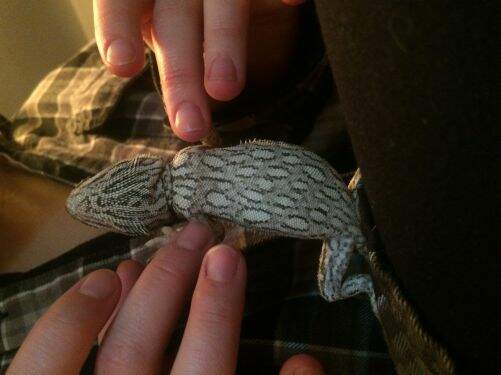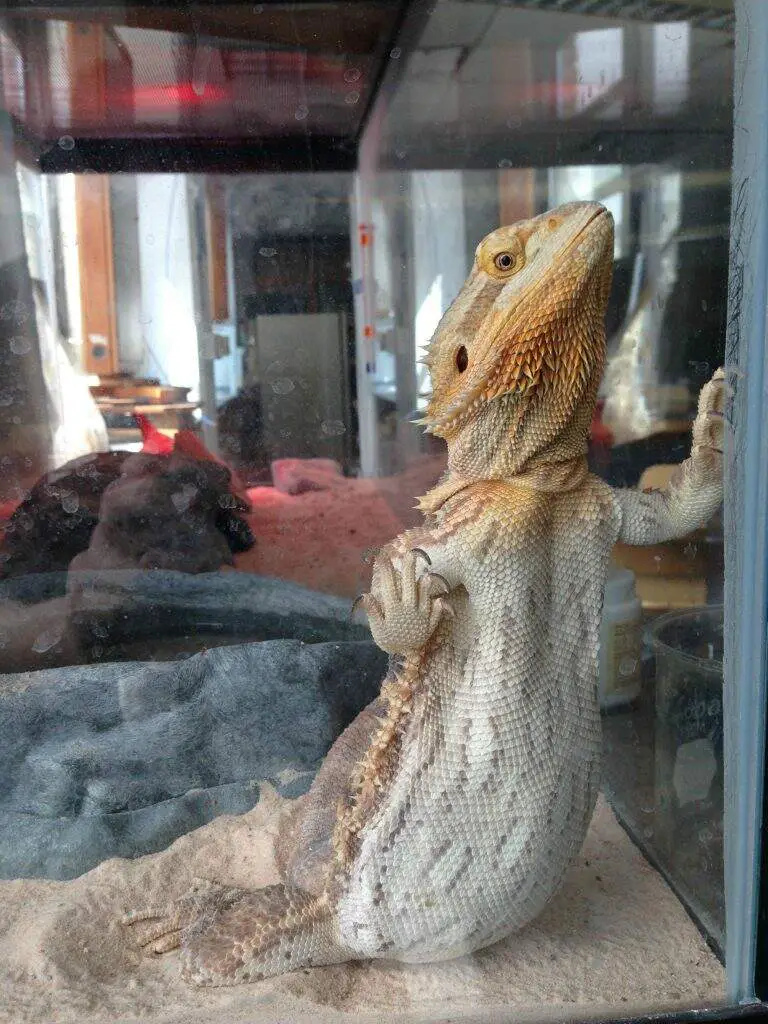Is your Beardie acting distressed? Below you’ll learn what causes stress marks in bearded dragons, signs of stress, and how to help.
You’ll learn:
- What are the main signs of stress?
- What are the top causes of stress?
- How can you help calm your Beardie?

Bearded dragons will usually show dark stripes or marks on its body and other behavioral signals that indicate distress. This guide will take you through the top signs of stress in beardies and how it can manifest physically. It will help you understand the possible causes of stress so you can try to address them and check if it may be an illness that needs medical attention.
7 Signs Of Stress In Bearded Dragons
1. Stress Marks
Dark markings, oval shapes, or dark lines similar to tiger stripes on a bearded dragon’s belly is a sure indication of stress. Sometimes they can be on the dragon’s chin and limbs as well. These stress marks are common to newly acquired beardies that are still adjusting to their new surroundings.

How Long Do Stress Marks Last?
Stress marks can last anywhere from a few days to as long as a month. With consistent stress, the marks can last longer. Sometimes it can just be for a few hours as your beardie experiences temperature changes (from day to night). For newly acquired beardies, these stress marks will clear as it gets used to their new home which can sometimes take a month. Make sure that your enclosure has all the proper requirements for temperature and lighting so that there are no added stressors for your new pet. Providing a hiding spot will make your dragon feel safer and help it acclimatize quicker.
2. New Dark Coloration
A darker coloration especially near its chin or beard is a typical sign of stress. However, this may also signify the start of shedding. Wait a few days and check if your beardie’s scales seem off or its tail starts to turn grey which are signs of shedding. If it does not shed, then you may need to bring it to a veterinarian.
📚 Read More >> Why Do Bearded Dragons Turn Black?

3. Loss of Appetite
Bearded dragon appetite is affected by their environmental temperature so if you notice changes in appetite, it may be feeling too cold. Make sure your thermometer and hygrometer are accurate and that the basking area or warm spot of your enclosure is at 95-110°F. You can also try offering treats such as fruits, mealworms, waxworms, papaya or mangoes. If it starts to eat, then you may simply have a picky eater. However, if the temperature is fine and your dragon refuses a treat then you should take it to the vet.
4. Lower Activity Levels
A sluggish and lethargic dragon can also be a sign of stress. If you notice that your dragon has lower activity levels or is hiding for prolonged periods of time, check the temperature, lighting, and humidity of its enclosure (make sure your UVB bulbs are still efficient). You should also pay attention to its diet. Make sure that your beardie is getting adequate nutrition from a balanced diet that’s appropriate for its age. You may also want to give your beardie some supplements such as calcium powder and vitamin D.
5. Not Basking Enough
If your beardie is not basking as often, it won’t be able to get the proper heat and light it needs for good health. Monitor the temperature of your enclosure and make sure that a good gradient from the hot and cool spots is established. The basking area may not be hot enough, so check the efficiency of your basking lamp as well. Sometimes, you can try switching out the hot and cool side of the tank to force your dragon to bask. However, keep in mind that changing its surroundings too much can also cause it undue stress. Before moving things around in its tank, check that everything else such as temperature, lighting, and humidity is in order.
6. Aggressive Behavior
Aggression due to stress in beardies can be due to leftover crickets that are biting it so make sure you clear all uneaten food 15 minutes after feeding. If your dragon has cage mates, then it may be being bullied by the bigger lizard. You may also be handling your dragon less causing it to turn a bit aggressive towards you. Signs of aggression include a darkened and puffed up beard, an open mouth, and head bobbing.
7. Frantically Clawing The Sides Of Their Terrarium
If you see your dragon “glass surfing” or clawing at the sides of their tank frantically, then it may have seen its own reflection and thought that it was another dragon. Beardies can get territorial so avoid this by setting up a background to cover the three sides of your aquarium or check the placement of your lights and/or tank to avoid any reflections. You should also check that the temperature is not too high which may cause increased activity. Sometimes, this may be a sign that your beardie wants to go out and explore or simply misses being handled – this is especially true for beardies that are used to being out of their cages.
📚 Read More >> Bearded Dragon Digging Behavior

5 Causes Of Stress
Bearded dragons can be stressed due to many possible causes, most of which are environmental and can be addressed easily. A well set up enclosure with the appropriate temperature, humidity, and lighting and a proper diet for your dragon will help avoid any undue stress. However, if in doubt or you notice that the stress may be due to an illness or injury, then you should definitely bring your beardie to a vet.
1. Incorrect Tank Temperature
Temperature and lighting (UVA/UVB light) are two of the most important factors that affect a lizard’s health. Bearded dragons are no different – they need a good temperature gradient in their tank to help with digestion, appetite, and body temp regulation. Make sure that you have an accurate thermometer and that your bulbs are still efficient. If you can, create a basking area with multiple levels (one very near the light and another slightly lower) so your beardie has the option to adjust according to its comfort. If the tank temperature is lower than recommended, it can cause a loss of appetite. This should be avoided especially during the growth phase. Sometimes, if your tank is on the smaller side, a good temperature gradient is not established and the temperature in your tank is either too high enough or too low for your bearded dragon’s comfort.
2. Wrong Sized Tank
Bearded dragons need plenty of space to move around and roam in. They do like exploring but hiding spots in their tank will also help make them feel safer. Small tanks can stunt the growth of juvenile dragons and lead to other diseases, causing stress. If they grow bigger, you will have to adjust their tank size so you might as well get a big tank at the start (50-55 gallons).
3. Relocation Stress
The first time you bring a beardie home, it will be stressed for sure as it adjusts to its new surroundings. The best thing to do here is to be patient with your beardie and give all the requirements it needs for a good home. You may notice darkening of the beard, loss of appetite, lack of bowel movement or runny feces, and inactivity during this period of adjustment. Relocation stress may last from a few weeks to a month. A responsible breeder will often make sure baby dragons get used to handling at a young age so their transition to new families is easier.
Quick Tips For Dealing With Relocation Stress In Bearded Dragons
To deal with relocation stress, limit handling and try not to overwhelm your new dragon even if you’re really excited about it. Reduce its sensory intake by covering a part of the tank with a towel and providing it with extra places to hide and help it feel safe. Make sure there’s no noise near its tank and that your family does not overcrowd near it too much.
Help it get used to your smell by placing an article of clothing you own in the tank and showing your palm face up in the tank a few minutes at a time to help it get used to your presence. Any time you’re reaching in from above the tank, go slow, and try not to startle your dragon. If you can, approach slightly from the side or the front so you don’t seem like a predator to your new beardie. If you need to pick up your bearded dragon, support its legs and tails to help it feel secure.
Food is always a good de-stressor so feed your new beardie every day making sure that no crickets are left in the tank after feeding as these can bite your beardie and cause more stress. You can also use tweezers to feed it during this adjustment period.
New beardies should never be housed with another bearded dragon as they can get territorial and resort to bullying. Bigger beardies will bully smaller ones and cause stress. They tend to take the best basking spots and food.
The best thing to do would be to leave your new beardie alone unless necessary and give it time to get acclimatized.
4. Excessive Handling
Excessive handling may also be causing your dragon undue stress. If you find it evading you or hiding immediately after handling then reduce interaction times until it feels comfortable again. Remember to fully support its legs and tail to help it feel secure during handling.
5. Loud Noises
Always approach your bearded dragon with a soft, calm tone and speak softly when approaching the tank so that it gets used to the sound of your voice. Don’t put their tank in an area with a constant source of noise like a television. Avoid putting your feeder insects in the same room since your dragon will hear them and be stressed that it can’t get to them.
Others causes of stress
- Crickets will bite bearded dragons if left in the tank after feeding. Make sure to clear uneaten food 15 minutes after feeding and check that none are hiding in the enclosure.
- Boredom and lack of attention may also be getting to your dragon so let it out of its enclosure to exercise or add new hiding spots or elements in your tank for it to explore.
- A dirty enclosure can also cause stress and unwanted bacterial growth that can make your dragon sick.
- Other pets that your dragon can see through its tank might scare and threaten it.
- Sometimes, especially for smaller beardies, too much open space in its enclosure can stress it out since it may feel too exposed or make it harder to hunt for its food. Try adding a divider or more hiding places in your enclosure you can just take out as your dragon grows.
How Can I Calm My Bearded Dragon?
If you have a new bearded dragon then you should limit handling and be patient. Give it time to get used to its new surroundings. If you’ve had your beardie for a while then check all the possible causes listed above. The list below also gives tips on how to help calm down a stressed bearded dragon.
Prevent Boredom With Tank Decor
Bearded dragons love the opportunity to explore so new tank decor can help keep it engaged. Give your beardie branches to climb, different basking levels, faux caves to hide in, and some plants to mimic their natural habitat.
Optimize Tank Conditions
The optimal tank conditions for lizards with regards to lighting, heating, and humidity can never be emphasized enough. These are all essential to your bearded dragon’s health and should be closely monitored. Aside from these, make sure your tank has adequate space, a nice basking spot, and several hiding areas for your dragon. Water should also be provided at all times.
Proper Diet
Bearded dragons need to have the proper ratio of live food such as crickets and worms as well as vegetables during different stages of their lives. As hatchlings and juveniles, they need more protein in their diets, transitioning to more vegetables as they age. Always take out uneaten food from the tank after feeding.
Give Them A Warm Bath
A 20 minute warm bath (85-92°F) may also help but only do this if your beardie is already comfortable with handling, otherwise the bath will stress it out further. Make sure the water does not get into its eyes and nose. A warm bath will help with your beardie’s hydration and cleanliness and help calm it down.
Conclusion
Signs of stress in bearded dragons often manifest as dark marks on its belly. The cause is usually related to its environment so always make sure that its enclosure has all the proper requirements especially when it comes to heating and lighting. If you’ve exhausted all the possible ways to calm down your beardie and it is still showing signs of stress then you should bring it to a herp vet immediately to get checked.
FAQs
Should You Be Worried About Stress Marks On Your Bearded Dragon?
Newly acquired bearded dragons will almost always develop stress marks since it will be worked up from all the extra stimulation as it gets relocated. These will usually clear from a few weeks to maybe a month as your dragon adjusts and feels more comfortable.
If your beardie has been with you for a while and it develops stress marks then check its surroundings and observe if it may be ill. Usually, these are caused by minor environmental changes that you can easily address. Just make sure that its habitat meets all the requirements to keep your bearded dragon happy.
How Long Do Stress Marks Take to Disappear?
Stress marks for new beardies usually take about a week, to sometimes, a month as it gets used to its new home. These stress marks can also appear with temperature changes from day to night and clear up shortly after morning. Some studies suggest that like chameleons, most reptiles like bearded dragons can darken their skin a bit to help it absorb more heat. If the marks persist for a long time, you should get your bearded dragon to the vet.
Why Do Baby Bearded Dragons Get Stress Marks?
Baby bearded dragons can have stress marks especially due to relocation stress as they take in all the unfamiliar sights and sounds of their new environment. Some can be due to most of the reasons that stress out older dragons listed above but some can also just appear for no reason and should disappear with age. There are reports of baby dragons being stressed out and showing stress marks in large tanks as they may feel vulnerable with all the open space. Get creative by putting a divider in your tank you can take out as your dragon grows or put hiding places to help make your dragon feel safe. Also check that the correct temperature for baby bearded dragons is met in your tank (100-110°F in the hot side and 80-90°F in the cooler side).
Further Reading
Comprehensive bearded dragon care sheet you can print (PDF):
Care Sheet – Bearded Dragon
A full and exhaustive guide to bearded dragons from taxonomy, history, behavior, breeding, and many more:
Husbandry Manual For Bearded Dragons. Reptilia: Agamidae
Explaining common myths and facts about bearded dragon care:
Myths and Facts about Bearded Dragon Care
A list of common diseases affecting bearded dragons:
Bearded Dragons – Diseases
Forum on what may stress out bearded dragons with accounts from owners:
What might stress out my bearded dragon?


